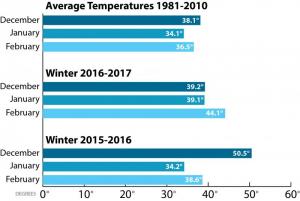Farmers brace in face of changing climate
People – and plants – were in for a rude awakening in mid-March when summer-like temperatures suddenly dropped.
This year's unusually warm winter, followed by a burst of cold, echoes conditions in early 2016 when trees bloomed early and were destroyed by an early April frost. It's still too soon to see that kind of damage, said Charles Smith, a horticulturist and one of the brothers who own and operate Bridgeville-based T.S. Smith and Sons farm.
“This year we may experience some damage, but I don't think it's had an economic impact yet,” Smith said. “But we're a long way from being out of the woods.”
Charles Smith's brother, Thomas Smith, said last year the farm lost about 60 percent of its peach crop and nearly all of its nectarines. It was the first time in a decade the Smith brothers had to use a helicopter to try to keep earthly warmth from rising above the crops, but even that extreme measure did little to fight Mother Nature.
“It seems like we're in this cycle of climate change, and I'm so aggravated the present administration doesn't even recognize it,” Charles Smith said. “It's devastating to an industry like ours and people who depend on the weather. It's my biggest concern as a farmer.”
State Climatologist Dan Leathers said 2016 is tied for the fifth warmest year on record in Delaware, reaching about 2 degrees above normal. As for winter 2016-17, which includes December through February, Delaware has seen another extremely warm winter season, with temperatures 4.4 degrees above normal.
Since record keeping began in 1895, data show Delaware winter temperatures have been increasing, Leathers said.
“Four of the five warmest winters have all been since 2000. When it comes to what we're seeing now, if you look back to 1895, no matter the season, we've had a slow, steady increase in temperature that's consistent with a generally warming climate.”
The Dust Bowl winter of 1931-32 also made the top five, Leathers said.
Leathers said January 2017 was about 5 degrees above normal, while preliminary data show February will break records as the warmest February since 1895, with temperatures averaging 7.6 degrees above normal.
“Then we got to March and things have radically changed,” he said, predicting a cold period beginning around March 13 to last 7-10 days. “It's not all that amazing during winter, especially toward spring, to see some of those big temperature swings.”
Temperatures swings, especially in the winter, are generally normal because of the movement of the jet stream. The ridges and troughs in the jet stream cause that variability, Leathers explained.
“They're constantly moving from west to east. Sometimes they're moving slow, other times they're moving quite quickly. It's not unusual to have big swings,” he said.
The drastic change between the ridge and trough, from extreme warm to extreme cold temperatures, also is due in part to global climate change, said John Byrne, director at the University of Delaware Center for Energy and Environmental Policy and a contributor to Intergovernmental Panel on Climate Change reports since 1992.
“Between the ridge and the trough, we see swings that are larger,” he said. “The overall trend is warming, but there's this variation that occurs. We actually see more extreme cold events in the winter and more extreme warm events in summer.”
Byrne said these variations and sudden temperature changes, as well as warmer winters overall, will continue to pose a challenge to the agriculture industry.
“Whatever we try to do now to abate the problem, it's going to take decades to remove this kind of variation,” he said. “The industry is going to face this kind of variation for some time. We need to focus on resilience and adaptation as well. It's going to get more difficult, not less.”
Luckily for local farmers, mid-March is very early in the growing season, when many farmers are still working in greenhouses or just getting ready to plant. But when it comes to flowering trees, such as peach trees, Charles Smith said those crops are beginning to bloom earlier because of the abnormally warm winter temperatures.
“Everything is pretty much three weeks ahead of schedule,” Charles Smith said. “I'm showing some varieties right now with some blooms showing, but by no means are they in full bloom. But the situation we're in with things being so early, if we have a warm snap next week and we approach full bloom by the end of the week, we'll have to cross our fingers.”



























































